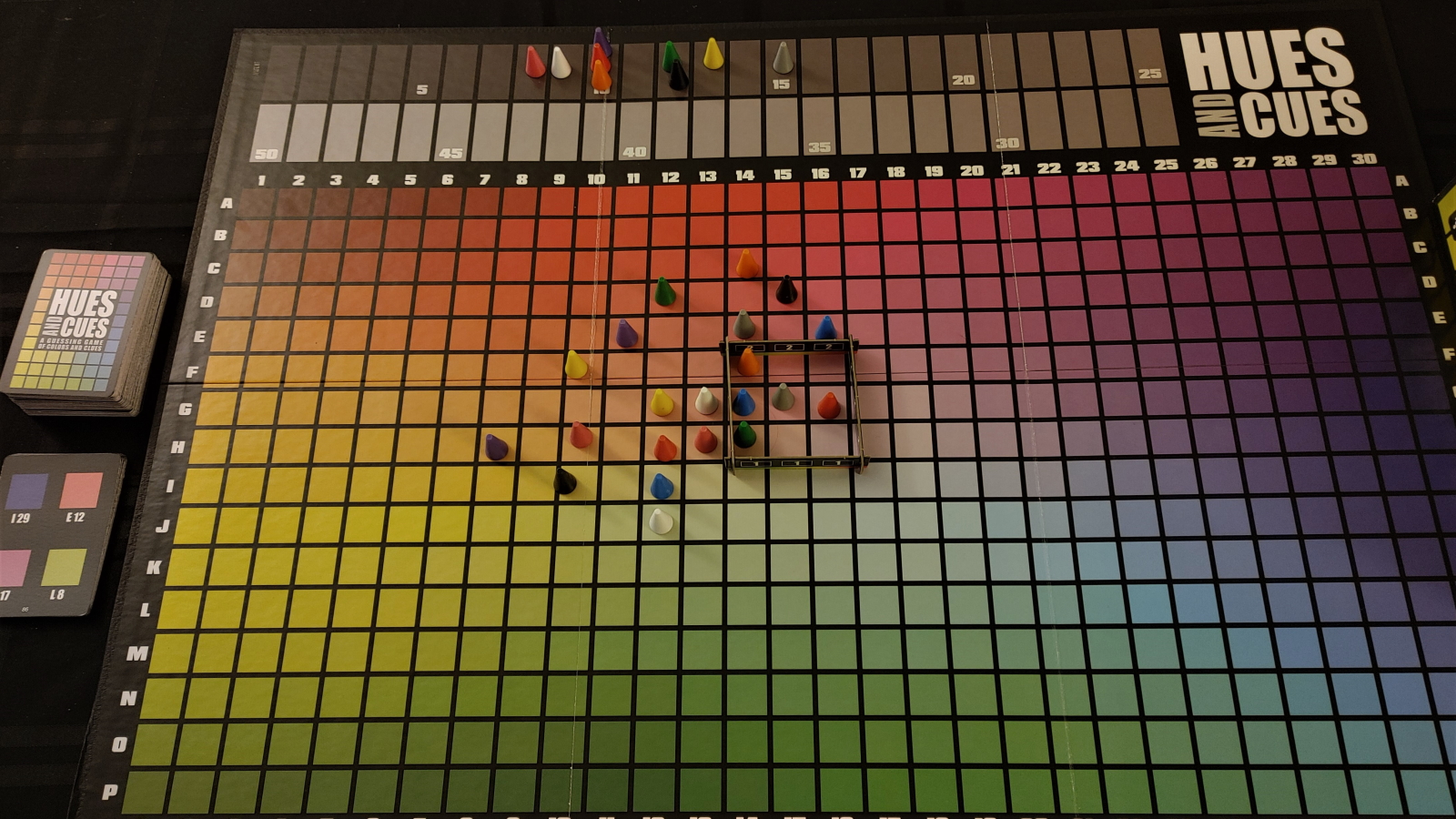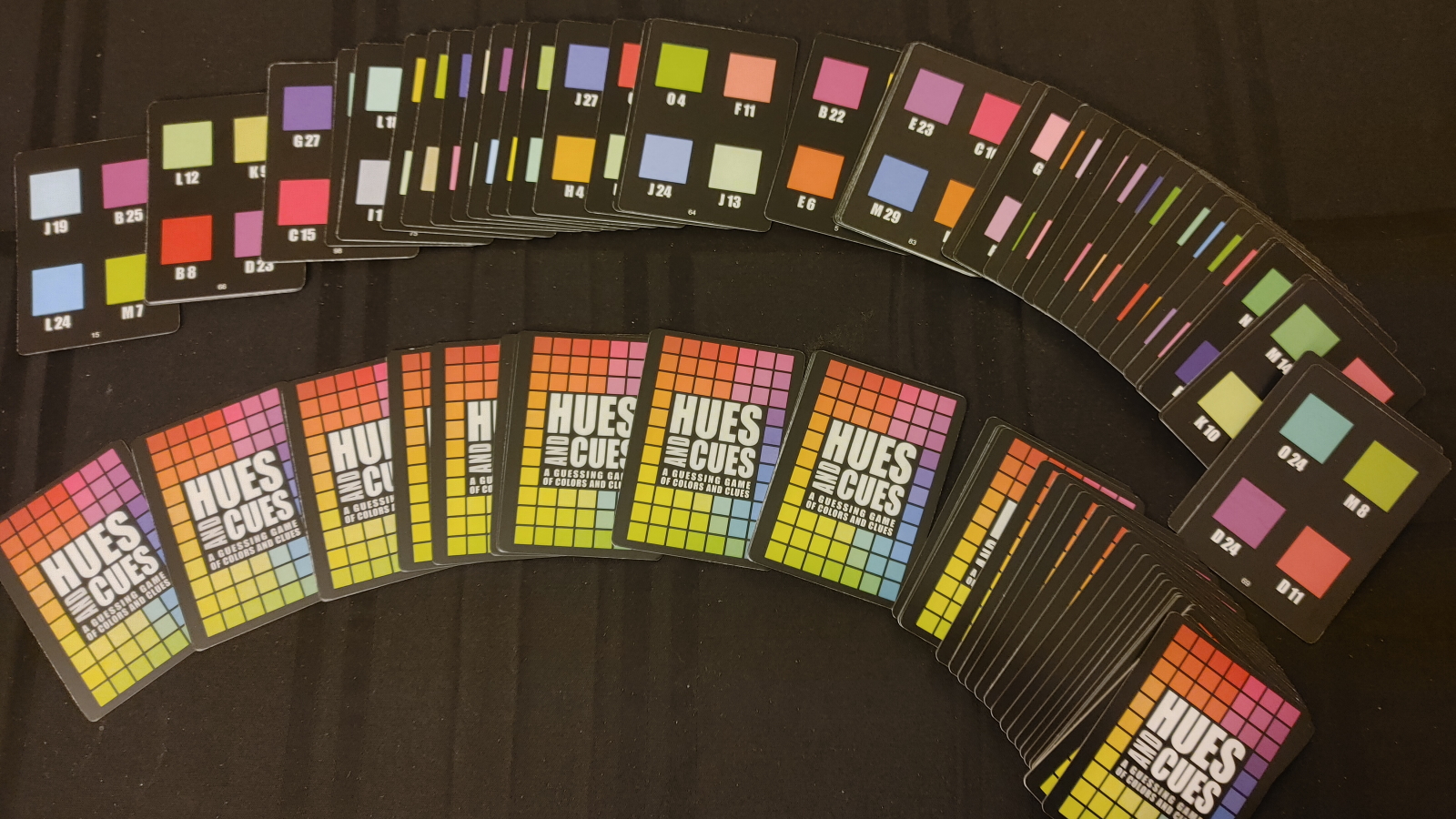
What color, exactly, is “lavender”? How about “traffic cone”? “Human Tongue”? Knowing the answer is the difference between winning and losing in Hues and Cues, a color guessing game for 3 to 10 players published by The OP.
In Hues and Cues, each player will take turns being the cue-giver. The cue-giver draws a card from the deck, and chooses one of 4 colors available on the card. They then give a single word clue to that color, avoiding the basic colors such as green, red, or purple. The rest of the players then take turns placing their cones on the colored space they think most closely represents that clue. If the cue giver is happy with the results, they can score immediately, or shoot for more points by giving a second, 2 word clue. Of course, that also gives other players a chance to get more points too.
The scoring is the most exciting part of the game, really. When scoring, an adorable little cardboard box included with the game shows who gets how many points. Each player that has a cone at the exact center of the box, which is the exact space on the cue-giver’s card, gets 3 points. If it’s one off, so just inside the box, they get 2 points. If it’s outside the box, but touching its side, they get 1 point. The cue giver gets a single point for each cone inside the box. After everyone’s had a turn, the game ends and the person with the most points wins. This unique scoring mechanic means that the cue giver can risk giving a dominating player more points to maximize their scoring, or can choose to take what they’ve already earned. It also means that the mechanics around scoring shift pretty dramatically depending on the player count.

This is one of those games with hidden depths. It sounds simple when someone says “sunshine” but what does it mean when that same player’s second clue is “Lemon splash?” Your eyes play tricks on you as the cue giver as well, as you look at the card and see a color that seems CLEARLY to be a very dark purple. You give the clue “Plum” and watch in horror as everyone chooses options even darker than what you wanted them to. Then you try to fight back with a “grape flavor”, which points them more to the blue hue, instead of your simple purple.
And that’s the most interesting part of the game. Color is one of those things that is extremely subjective. Sure, there are wavelengths that can be measured, but there’s always been disagreements between when red changes to orange, or when blue turns to green. Those unknown differences get surfaced by Hues and Cues, leading to absurd clues like “margherita”, “deep water”, or “stop sign”.
Hues and Cues is also extremely easy to teach. The score-box is a dead-simple mechanic to explain, and, outside of color-blind folk, colors are a shared language. It takes maybe 2 minutes to set up, 3 minutes to teach, and 30 minutes to finish a game. If you have a large party and want a quick and easy game to start a night off right, Hues and Cues is definitely a great place to begin. My only real complaint about the rules are the clues you cannot give, namely the basic colors (which are almost default in your head), lighter, darker shade clues, repeated clues, or things in the room. These rules are for the health of the game, of course, but there are enough forbidden words that someone is going to use one on accident.

My biggest concern is the build quality. The game is cheap for a game like this at $25 USD, but boy does it feel its price. The fold out board, while beautifully vibrant, doesn’t sit flat for me. The cards are spot on for color, but feel flimsy. I’m definitely going to get these cards into sleeves at my first available opportunity.
One final concern I have regards color-blind people. I like board games to be as inclusive as possible, but I really don’t see how it’s possible for a color-blind person to have fun with this game. Even if a person is only partially color-blind, you might be unable to use half the board. This is a shame, since I would otherwise give this game my full hearted recommendation to everyone. Instead, I think I can say that if your group doesn’t have a color-blind person, you should look into getting this game. It’s definitely a good time, but it’s not worth leaving someone out of the fun.
Hues and Cues
Excellent
A colorful guessing game with a novel scoring mechanic. The scoring itself lends to some interesting strategy and risk taking. Hues and Cues is very simple to teach, fun to play, and a great social experience. Low build quality and no accessibility options for color-blind prevents it from being a perfect game.
Pros
- Brilliantly colorful board
- Fun scoring mechanic
- Great party game
Cons
- Low quality cards and board
- No accessibility towards the color-blind
- Easy to forget what you cannot say as a clue
